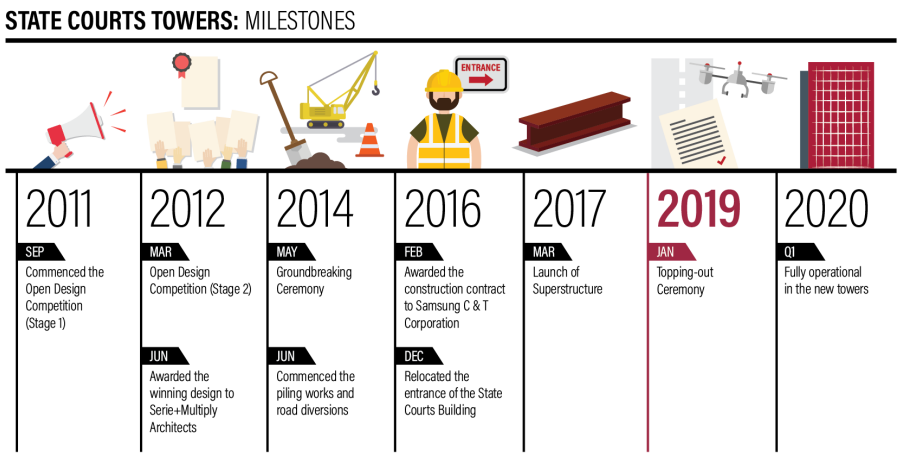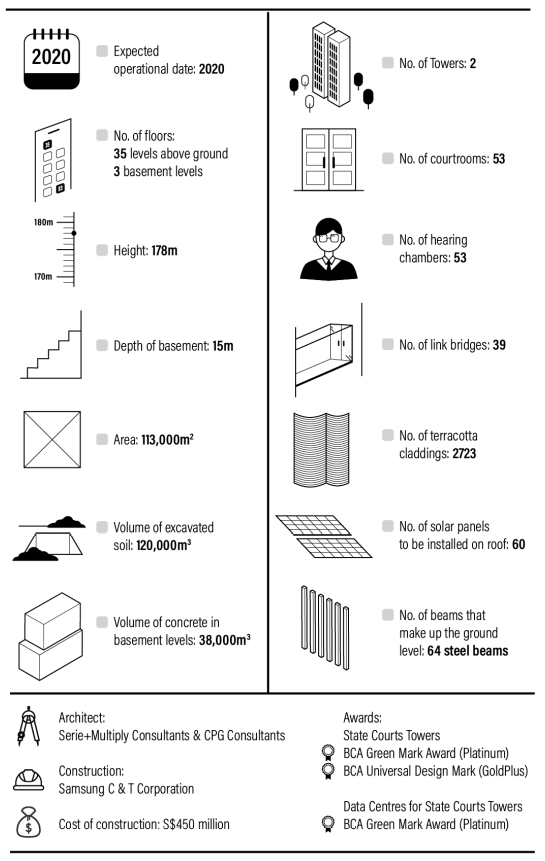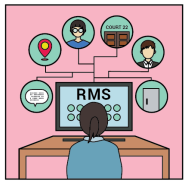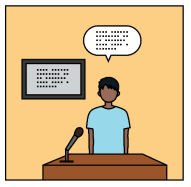Official website links end with .gov.sg
A Singapore Government Agency Website
Secure websites use HTTPS
Media Release: State Courts see completion of structural works of new towers
The State Courts marked the on-schedule completion of the structural works of the new State Courts Towers today, with a Topping-out Ceremony which was officiated by The Honourable the Chief Justice Sundaresh Menon. The event saw the launch of a drone, which scaled the new 35-storey State Courts Towers to place the symbolic final amount of concrete to top-out the structure. Standing at 178 metres, the building which comprises a court tower and an office tower is the tallest government building in Singapore to date. It will be fitted with 53 courtrooms and 53 hearing chambers, with additional space to fit out more in the future. Currently, there are 37 courtrooms and 40 hearing chambers in the existing building.
IT-enabled courthouse
2 Behind the steel beams and concrete, the public can expect a modern courthouse which will employ various technologies to effectively deliver services to court users and to manage resources. For example, the Resource Management System (RMS) will be used to ensure optimal allocation of manpower and physical resources within the new towers. With integration to the case management systems of the State Courts, the RMS will be able to dynamically deploy court interpreters in real-time according to their language and dialect proficiencies, and where necessary, according to their fields of specialisation. The system will also be used to aid the deployment of court officers and for courtrooms and hearing chambers assignment.
3 Other IT or web-enabled services that will be deployed in the new building include video-conferencing facilities in 19 courtrooms, Assistive Listening Systems in all courtrooms, the Speech Transcription System which will instantly transcribe oral 2/6 evidence in real-time and interactive self-service kiosks providing informational and payment services on multiple floors. Smart building technologies such as facial recognition and the automation of processes to manage the building operations related to security and the mechanical and electrical operations such as ventilation, cooling, lighting and elevators add to the suite of technologies used in the new State Courts Towers.
Construction
4 Since the construction works began in 2014, the project has faced challenging site constraints such as being sited on a relatively small land plot, surrounded by major roads. The use of innovative construction methods has helped to achieve on-schedule project completion. One of such innovations is the advanced construction method used in building its floors with long span steel decks. This method reduced the number of steps in the process and helped to optimise resources.
5 The impending move from a nine-storey building to a 35-storey building, presents both opportunities and challenges to the way that the State Courts operate. Justice See Kee Oon, Presiding Judge of the State Courts said, “The State Courts face rapid changes in both the physical and contextual environments. We must be alive to these and continue to adapt and keep apace of the environment that we operate in. We will look towards harnessing technology where possible, for the efficient administration of justice and to meet court users’ evolving needs as we move forward to a new beginning.”
6 As the jurisdiction and case load as well as new functions of the State Courts increased over the years, it was determined that the current building would not be able to support future needs. And hence, expansion plans for the new building were mapped out in 2011. The ground breaking ceremony was held in May 2014 and the construction of the superstructure commenced in March 2017. The State Courts towers are expected to be operational in the first quarter of 2020. The building will also adopt eco features and a Universal Design approach to ensure that it is user-friendly to persons with disabilities, the elderly and young.
Issued by: State Courts, Singapore
Date: 25 January 2019
Enclosed:
(i) Opening Address by Justice See Kee Oon, Presiding Judge of the State Courts for Topping-out Ceremony of the new State Courts Towers
(ii) Annex A – Factsheet: State Courts Towers milestones
(iii) Annex B – Factsheet: State Courts Towers key facts and figures
(iv) Annex C – Factsheet: Technologies in the new State Courts Towers
*High-resolution photos and a construction time-lapse video are available via download link.
For further information or clarification, please contact:
(i) Ms Marilyn Tan, Assistant Director, Communications Directorate
Tel: 6435 5652 / 9722 6139
Email: marilyn_tan@statecourts.gov.sg
(ii) Mr Bryan Jacob, Executive, Communications Directorate
Tel: 6435 5088 / 9722 6139
Email: bryan_jacob@statecourts.gov.sg
Annex A
FACTSHEET

Annex B
FACTSHEET STATE COURTS TOWERS: KEY FACTS AND FIGURES

Annex C
FACTSHEET TECHNOLOGIES IN THE NEW STATE COURTS TOWERS
Resource Management System

An automated system in the pipeline, the Resource Management System (RMS) will assist in the optimal allocation of manpower and physical resources within the State Courts. With integration to the Human Resource Management System and case management systems of the State Courts, the system will be able to dynamically deploy court interpreters in real-time according to their language and dialect proficiencies, and where necessary, according to their fields of specialisation. The system will also be able to response to ad-hoc requests as completion of assignment is captured in real-time. The RMS will also be used in the deployment of court officers, and in courtrooms and hearing chambers assignment.
Speech Transcription System

The Speech Transcription System (STS) is real-time transcription system that is able to transcribe oral evidence in court proceedings instantly; allowing parties to access the transcripts on individual computer screens in the courtrooms and hearing chambers. Powered by a speech recognition engine that is trained with court-related terms and phrases, the system will be able to recognise legal jargon as well as domain-specific terminology such as medical terms used in Coroner’s Inquires. Real-time access to court transcripts will allow more effective participation by parties in court proceedings and parties will be able to conduct their cases in an expeditious manner. The STS is currently at a proof-of-concept stage and is expected to be completed in 2019.
IT-enabled courthouse
2 Behind the steel beams and concrete, the public can expect a modern courthouse which will employ various technologies to effectively deliver services to court users and to manage resources. For example, the Resource Management System (RMS) will be used to ensure optimal allocation of manpower and physical resources within the new towers. With integration to the case management systems of the State Courts, the RMS will be able to dynamically deploy court interpreters in real-time according to their language and dialect proficiencies, and where necessary, according to their fields of specialisation. The system will also be used to aid the deployment of court officers and for courtrooms and hearing chambers assignment.
3 Other IT or web-enabled services that will be deployed in the new building include video-conferencing facilities in 19 courtrooms, Assistive Listening Systems in all courtrooms, the Speech Transcription System which will instantly transcribe oral 2/6 evidence in real-time and interactive self-service kiosks providing informational and payment services on multiple floors. Smart building technologies such as facial recognition and the automation of processes to manage the building operations related to security and the mechanical and electrical operations such as ventilation, cooling, lighting and elevators add to the suite of technologies used in the new State Courts Towers.
Construction
4 Since the construction works began in 2014, the project has faced challenging site constraints such as being sited on a relatively small land plot, surrounded by major roads. The use of innovative construction methods has helped to achieve on-schedule project completion. One of such innovations is the advanced construction method used in building its floors with long span steel decks. This method reduced the number of steps in the process and helped to optimise resources.
5 The impending move from a nine-storey building to a 35-storey building, presents both opportunities and challenges to the way that the State Courts operate. Justice See Kee Oon, Presiding Judge of the State Courts said, “The State Courts face rapid changes in both the physical and contextual environments. We must be alive to these and continue to adapt and keep apace of the environment that we operate in. We will look towards harnessing technology where possible, for the efficient administration of justice and to meet court users’ evolving needs as we move forward to a new beginning.”
6 As the jurisdiction and case load as well as new functions of the State Courts increased over the years, it was determined that the current building would not be able to support future needs. And hence, expansion plans for the new building were mapped out in 2011. The ground breaking ceremony was held in May 2014 and the construction of the superstructure commenced in March 2017. The State Courts towers are expected to be operational in the first quarter of 2020. The building will also adopt eco features and a Universal Design approach to ensure that it is user-friendly to persons with disabilities, the elderly and young.
Issued by: State Courts, Singapore
Date: 25 January 2019
Enclosed:
(i) Opening Address by Justice See Kee Oon, Presiding Judge of the State Courts for Topping-out Ceremony of the new State Courts Towers
(ii) Annex A – Factsheet: State Courts Towers milestones
(iii) Annex B – Factsheet: State Courts Towers key facts and figures
(iv) Annex C – Factsheet: Technologies in the new State Courts Towers
*High-resolution photos and a construction time-lapse video are available via download link.
For further information or clarification, please contact:
(i) Ms Marilyn Tan, Assistant Director, Communications Directorate
Tel: 6435 5652 / 9722 6139
Email: marilyn_tan@statecourts.gov.sg
(ii) Mr Bryan Jacob, Executive, Communications Directorate
Tel: 6435 5088 / 9722 6139
Email: bryan_jacob@statecourts.gov.sg
Annex A
FACTSHEET

Annex B
FACTSHEET STATE COURTS TOWERS: KEY FACTS AND FIGURES

Annex C
FACTSHEET TECHNOLOGIES IN THE NEW STATE COURTS TOWERS
Resource Management System

An automated system in the pipeline, the Resource Management System (RMS) will assist in the optimal allocation of manpower and physical resources within the State Courts. With integration to the Human Resource Management System and case management systems of the State Courts, the system will be able to dynamically deploy court interpreters in real-time according to their language and dialect proficiencies, and where necessary, according to their fields of specialisation. The system will also be able to response to ad-hoc requests as completion of assignment is captured in real-time. The RMS will also be used in the deployment of court officers, and in courtrooms and hearing chambers assignment.
Speech Transcription System

The Speech Transcription System (STS) is real-time transcription system that is able to transcribe oral evidence in court proceedings instantly; allowing parties to access the transcripts on individual computer screens in the courtrooms and hearing chambers. Powered by a speech recognition engine that is trained with court-related terms and phrases, the system will be able to recognise legal jargon as well as domain-specific terminology such as medical terms used in Coroner’s Inquires. Real-time access to court transcripts will allow more effective participation by parties in court proceedings and parties will be able to conduct their cases in an expeditious manner. The STS is currently at a proof-of-concept stage and is expected to be completed in 2019.
Topics:
Court initiatives
2021/10/13








